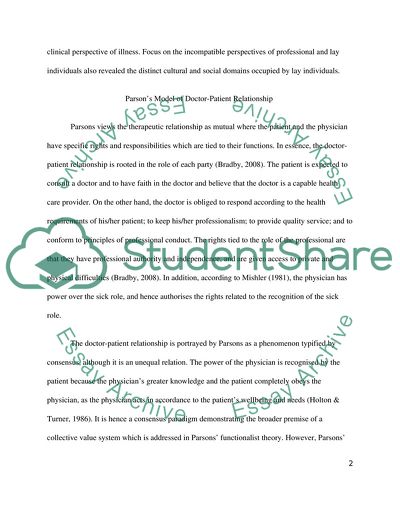Cite this document
(Parsons and Freidsons Models Essay Example | Topics and Well Written Essays - 1500 words, n.d.)
Parsons and Freidsons Models Essay Example | Topics and Well Written Essays - 1500 words. Retrieved from https://studentshare.org/health-sciences-medicine/1798730-since-the-1960s-various-conceptual-models-of-the-doctor-patient-relationship-have-shaped-sociological-research-into-medical-practice-critically-examine-those-of-parsons-and-freidson-are-these-models-still-relevant-today
Parsons and Freidsons Models Essay Example | Topics and Well Written Essays - 1500 words. Retrieved from https://studentshare.org/health-sciences-medicine/1798730-since-the-1960s-various-conceptual-models-of-the-doctor-patient-relationship-have-shaped-sociological-research-into-medical-practice-critically-examine-those-of-parsons-and-freidson-are-these-models-still-relevant-today
(Parsons and Freidsons Models Essay Example | Topics and Well Written Essays - 1500 Words)
Parsons and Freidsons Models Essay Example | Topics and Well Written Essays - 1500 Words. https://studentshare.org/health-sciences-medicine/1798730-since-the-1960s-various-conceptual-models-of-the-doctor-patient-relationship-have-shaped-sociological-research-into-medical-practice-critically-examine-those-of-parsons-and-freidson-are-these-models-still-relevant-today.
Parsons and Freidsons Models Essay Example | Topics and Well Written Essays - 1500 Words. https://studentshare.org/health-sciences-medicine/1798730-since-the-1960s-various-conceptual-models-of-the-doctor-patient-relationship-have-shaped-sociological-research-into-medical-practice-critically-examine-those-of-parsons-and-freidson-are-these-models-still-relevant-today.
“Parsons and Freidsons Models Essay Example | Topics and Well Written Essays - 1500 Words”, n.d. https://studentshare.org/health-sciences-medicine/1798730-since-the-1960s-various-conceptual-models-of-the-doctor-patient-relationship-have-shaped-sociological-research-into-medical-practice-critically-examine-those-of-parsons-and-freidson-are-these-models-still-relevant-today.


